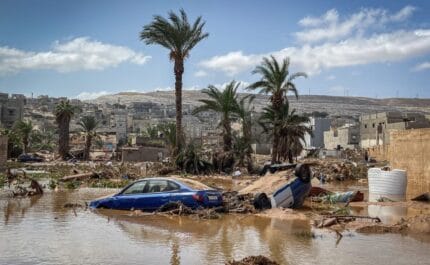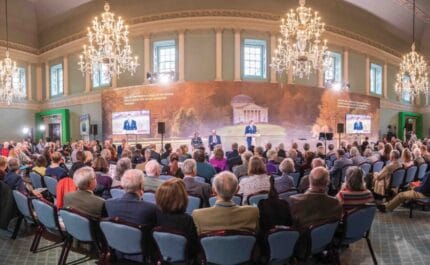The aftershocks
In issue 50 a huge earthquake shook Turkey, leading to tens of thousands of deaths. Mitra Nazar drove immediately into the destruction zone to bear witness: she reports on what she found in the aftermath of the disaster – and how the country has changed several months later
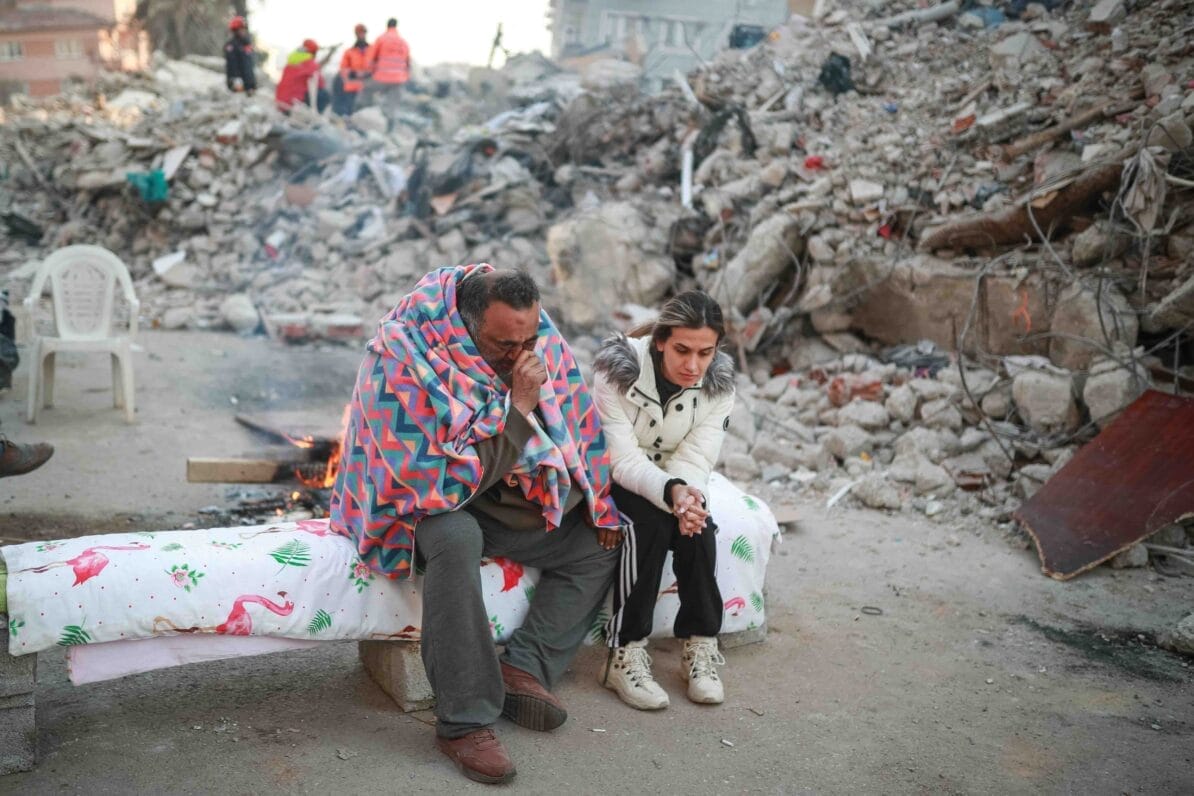
Earthquake victims sit among the damage in Hatay, Turkey. Within a week of the 6th February earthquakes the death toll in Turkey and Syria was over 35,000 people. Photo: Riza Ozel/dia images via Getty Images
6th February 2023 (Taken from: #50)
Saturday 11th February, five days after the earthquakes
The excavators at the cemetery in Adiyaman crunch and wail. Graveyards are usually quiet places, but not here. Not now. Five days have passed since two devastating earthquakes hit southeast Turkey and northeast Syria. Adiyaman, an ancient Turkish city of a quarter of a million people, has been destroyed. In the graveyard hundreds grieve or search for the bodies of their loved ones as the machines work around the clock. The sound is overwhelming.
In the first few days after the earthquakes every victim was buried in a separate space. Numbers were allocated to corpses, their details recorded, in the hope that unknown bodies could later be claimed. But now there is simply not enough room to accommodate the sheer number of dead in this way. Thousands have died, although no one is sure of the exact toll. The excavators dig mass graves.
Ahmet Eren points out over the cemetery, which has expanded into the wetlands behind the mosque. “My aunt is buried here, and two of my nieces,” he says calmly. “I don’t know exactly where. It all happened so quickly. I don’t know if we will ever find them.” A thin and bespectacled man, he has travelled here from the Netherlands, where he’s been living with his Turkish-Dutch wife for six years. The moment he heard about the quakes he got in his car and started driving. Three days later he arrived in the city where he had grown up, to find it decimated.
We walk along the piles of freshly-dug earth, each telling a different story. One of the graves looks wider than its neighbours. “This one, a mother and a child,” Eren says, pointing down to it. “They were found together, embracing. They died hugging each other. They were buried in the same way, how they were found.” The excavators stop suddenly, interrupted by the voice of an imam. Bodies arrive constantly, some in funeral vans, others on the back of pick-up trucks. The city has run out of body bags so they are covered in woollen blankets. Hundreds of volunteers help to carry the dead to the trench, one by one. The imam performs a prayer over each body. Eren tells me it is a shortened version of the usual prayer. “Everyone has to work really quickly,” he says. “There is no time.”
The clock is ticking. In Islam a body must be buried in an individual grave as soon as possible, usually within 24 hours. But mass burials are permitted in extreme circumstances. And after five days, even in the freezing cold of a Turkish winter, some bodies now arrive in a state of decomposition.
We see a woman kneeling on the ground. The grave of her loved one is marked by a stick, bearing just a number. She scribbles a name on it, crying silently.
Monday 6th February, the day of the earthquakes
I wake to my phone buzzing. It’s not yet 5am and I’m at home in Istanbul. The message is from an app which notifies me whenever there is an earthquake in Turkey above five on the Richter scale. This is an essential component of life in the country, which sits on several faultlines. Istanbul has been moulded by earthquakes and everyone here is waiting for “the big one”. One of the first things I did when moving here in 2020 was prepare a go-bag that I keep by the door. When I see the number, I jump up and run to my computer. The quake measures 7.8. The big one has finally arrived – just not in Istanbul.
At 4.17am millions of people in the southeast of Turkey and neighbouring Syria had been woken up by one of the biggest earthquakes the world has seen in the last 100 years. According to survivors the tremor lasted 75 seconds. It was so strong that roads were ripped apart, bridges snapped in two and thousands of residential buildings collapsed. A 300-kilometre-long crack was torn in the earth’s crust, right by the Turkey-Syria border.
Nothing has been heard from Adiyaman until I see a tweet from a resident: ‘Adiyaman no longer exists’”
The first images come out of the cities of Adana and Gaziantep. They show collapsed buildings and people out in the streets. The authorities speak of “hundreds” of deaths and many more injured, an estimate that will increase quickly over the following hours. The epicentre of the earthquake was near Gaziantep, a city of two million people, but no one knows how big the affected area is. The images are tragic but they are coming from places where some infrastructure does at least still exist, and where there is still an internet connection.
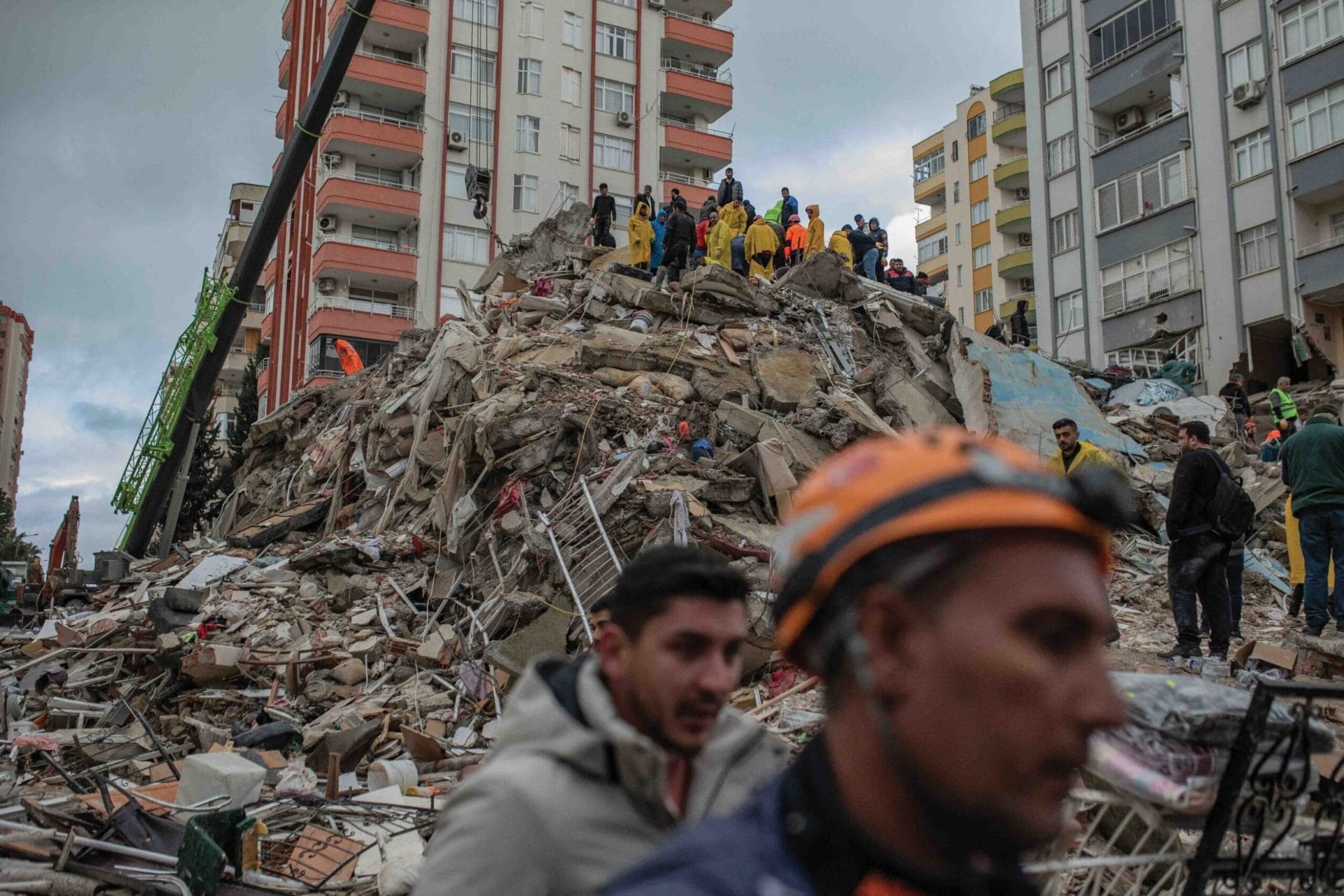
Rescuers search for victims and survivors amid the rubble of a building that collapsed in Adana, southern Turkey, 6th February 2023. Photo: Can Erok/AFP
At 1pm, some eight hours later, a second quake hits, measuring 7.6 on the Richter scale. It is initially thought to have been a strong aftershock, but it turns out to have been triggered along an entirely different faultline nearby. This time local camera crews quickly reach some of the affected areas. One channel broadcasting live from the scene shows people running and screaming, and buildings that remained standing after the first earthquake now crumbling into a wall of dust. Many who survived the first quake do not survive the second. As every hour passes more cities are added to the list of those affected: Kahramanmaras, Malatya, Sanliurfa. Slowly some phone lines and internet connections begin to return. Messages pour in from desperate people. Many post addresses on social media, locations where family members are trapped. There are messages from people who are themselves trapped under rubble, begging for help.
The worst fear is reserved for the places you don’t hear from. Antakya, the biggest city in Hatay province, near the Syrian border, has gone dark. Mountain roads have been cut off due to the damage, and the entire city has been without power and phone connections since the first quake. When images do start to come in, it becomes clear that this ancient city has been one of the hardest hit. And then there is Adiyaman, a beautiful, Kurdish majority city, usually a two-hour drive north east of Gaziantep. Nothing has been heard from there either, until I see a post from a resident on Twitter: “Adiyaman no longer exists”.
Tuesday 7th February
I manage to reach Adana the day after the earthquakes. The city has been affected but it was at the edge of the quake zone and has been spared the worst. The airport is operational again, and much of the wave of international aid is coming through it. The city, a little under 50 kilometres inland from the Mediterranean, has a population of over two million. Even if Adana has escaped serious destruction, it isn’t unscathed. On the road from the airport to the city centre I see many damaged homes. I drive towards a neighbourhood called New Adana, an upper-class district just outside the city centre. I am told that three high-rise apartment buildings completely collapsed straight after the first quake. When I arrive at one of the blocks, the first thing I see is a massive pile of concrete. I’m told by rescuers that it was a 14-storey-high building.
Teams from AFAD, the state’s emergency response body, are working around the clock. There are excavators, but their drivers must be careful in case people are still alive under the rubble. We wait and watch, as rescue workers delicately lift pieces of concrete. Hundreds of people stand on the street waiting for a sign of life from family members. Suddenly a rescue worker shouts “silence!”. They think they hear something, someone under the rubble, and everyone stops talking. Drivers of passing cars are asked to stop and turn off their engines. A dead quiet follows. It lasts a few minutes until suddenly the rescue workers start digging again – a false alarm. Whenever someone is found, white sheets are used so that the crowd and its cameras do not see the bodies. In the four hours I spend there, rescue workers take out three corpses.

A rescuer carries a body found in the rubble in Adana, 6th February 2023. Photo: Can Erok/AFP via Getty Images
While rescue teams from AFAD were able to reach Adana on the first day, it’s a very different reality elsewhere. In Hatay province, in the cities of Antakya and Samandag, people tell me that they don’t see rescue teams until the second or even third day.
The first 72 hours after an earthquake are crucial to the hopes of finding people alive. The rate of survival for those trapped in rubble is higher than 70 percent if they are found within 24 hours. By 72 hours that figure drops to barely 20 percent. On the fifth day the chance of finding anyone alive is just six percent. An effective relief effort makes a huge difference to survival rates. In Turkey the response is slow and disjointed; emblematic for many of a government that has failed its people. “In the first two, three days the emergency rescue teams could not reach areas like Hatay, Kahramanmaras and Adiyaman,” says political analyst Seren Selvin Korkmaz from her Istanbul office. “This was a huge problem. It means that the institutions do not work efficiently. My own family, who live in Malatya [an ancient city in eastern Anatolia] and saw their homes destroyed, could not find basic needs like water and bread for two days.” Like many others, Korkmaz points towards the government’s failures.
Turkey is ruled by one man, Recep Tayyip Erdoğan. Initially seen as a pro-western reformer when he came to power nearly two decades ago, Erdoğan has transformed Turkey’s vibrant civil society into one in which criticism isn’t tolerated. Most independent media have been shut down or taken over by allies of Erdoğan’s party, the AKP. The judiciary is no longer independent. The internet is heavily restricted and any criticism on social media can be punished with jail time for “insulting the president”, a previously obscure law that has been heavily utilised by Erdoğan to crush dissent. Turkey is one of the world’s leading jailers of journalists.
In 2017 Erdoğan made another power grab, calling a constitutional referendum that would change Turkey’s parliamentary system into an executive presidency. He narrowly won that referendum and the general election the following year. Although elections are considered relatively free in Turkey, they are not fair. The election monitoring team of the Organization for Security and Co-operation in Europe (OSCE) concluded that “voters [in 2018] had a genuine choice despite the lack of conditions for contestants to compete on an equal basis.” Erdoğan and his party, they said, “enjoyed a notable advantage, also reflected in excessive coverage by government-affiliated public and private media.” Political opponents have been targeted. Kurdish politician Selahattin Demirtaş, who came third in the 2018 presidential vote, ran his campaign from prison. He had been arrested in 2016 on what are widely seen as trumped-up terrorism charges. The European Court of Human Rights ruled that no terrorism links were proven and called for his “immediate release”. He remains in jail.
The Turkish state, throughout all of this, looked like a helpless bystander”
The new executive presidency granted Erdoğan nearly all the powers of the state. “It is Turkey’s weakest point right now,” says Korkmaz. “The presidential system has hollowed out all the institutions. It’s a system that promised to work fast because it would need an order from just one person on the top. But we have now seen that it does the contrary. It became paralysed. If Erdoğan’s order cannot reach the rescue workers, they can’t work. They were all waiting for an order from the top, and the system froze because the order wasn’t coming quick enough.”
An investigation by journalist Ragip Soylu for Middle East Eye published a month after the quakes shines a light on the government’s failures in the first few hours of the disaster. “Institutional decay, lack of coordination as well as the magnitude of the disaster prevented the Turkish government from responding well to the earthquake,” he writes. “Videos of survivors pleading for help went viral as volunteers shared thousands of addresses where victims lay buried under mounds of concrete and twisted metal. The Turkish state, throughout all of this, looked like a helpless bystander.”
Thousands of people were still trapped alive under the rubble, and nobody came to their rescue”
Government officials claimed it was a near impossible job. The areas in the southeast affected are remote and vast, about the size of Bulgaria: ten provinces, containing 13 million people. Airports were damaged. Roads were blocked by rubble. Weather conditions were terrible (it was snowing in much of the country) and many rescue workers were victims of the earthquakes themselves.
The collapse of the telecommunications network seems to have been a major contributing factor to the slow response. The government’s disaster plan anticipated that phone lines would be cut after such a big earthquake. But service providers had promised that the internet would be up and running almost immediately. That didn’t happen. On the first day, Elon Musk offered to turn on his satellite-based Starlink system to provide broadband in the earthquake zone. According to a source close to the government, quoted in Middle East Eye, the offer was rejected because they “wouldn’t be able to control and restrict the internet in the future. You cannot censor the internet when it is directly provided by satellite.” In the meantime, thousands of people were still trapped alive under the rubble, and nobody came to their rescue. Many are thought to have died not during the earthquake, but many hours, sometimes days, later because of exposure and hypothermia. As criticism of the response grew, Twitter was briefly blocked by the government. Deputy infrastructure minister Dr Ömer Fatih Sayan said the measure was necessary to combat “misinformation”. The block cut a vital communication tool for survivors and rescuers looking for loved ones still trapped.
Wednesday 8th February
Two days after the earthquakes, I drive to the port city of Iskenderun in Hatay province. The roads are cracked and dangerous. There I face an apocalyptic scene. Acrid, black smoke clouds hang above the city. A big fire has broken out among the shipping containers in the port. Nobody knows what was inside the containers that are ablaze or what is in the smoke. The earthquake caused the sea level to rise temporarily and seawater has poured into the city, filling the streets. People walk around in pyjamas. There are collapsed buildings on every corner. On top of the rubble of what was once a five-storey building, ten men work to find survivors.

Collapsed buildings in Hatay, with smoke from a fire at the port rising in the distance. Photo: Burak Kara/Getty Images
One elderly man stands between them, wiping tears from his face. His family lived in a flat in that building. His daughter, her children. There isn’t much hope of finding them alive, but the dig continues regardless. One of the rescuers had seen a body of a woman, impaled by a piece of metal, although they aren’t sure if it is the man’s daughter. They dig using a single large hammer someone has brought them, and with their bare hands. To reach the people on the lower floors, they need heavy machinery. They need professional help.
Volunteers are now flooding in. Among them are mine workers’ groups, mountain climbers, volunteer doctors and nurses. They come from all over the country. Cars set out from up to 1,000 km away. Groups of friends in Istanbul have mobilised and jumped in vehicles to come and do whatever they can to help. There is so little faith in the government’s response that donations are pouring into independent NGOs rather than AFAD. More professional rescue teams and industrial excavators are en route. From all over the world, help is arriving.
I leave Hatay province that evening as there is nowhere to sleep. No building left standing looks safe. Aftershocks frequently rumble beneath my feet. Buildings still suddenly collapse throughout the affected area. It takes a couple of hours to reach Sanliurfa, an ancient city home to what is thought to be the world’s oldest temple complex, Göbekli Tepe. A few neighbourhoods have collapsed buildings and there are many deaths here, but large parts of the city still stand strong. A few hotels have opened their doors to rescue teams and journalists.
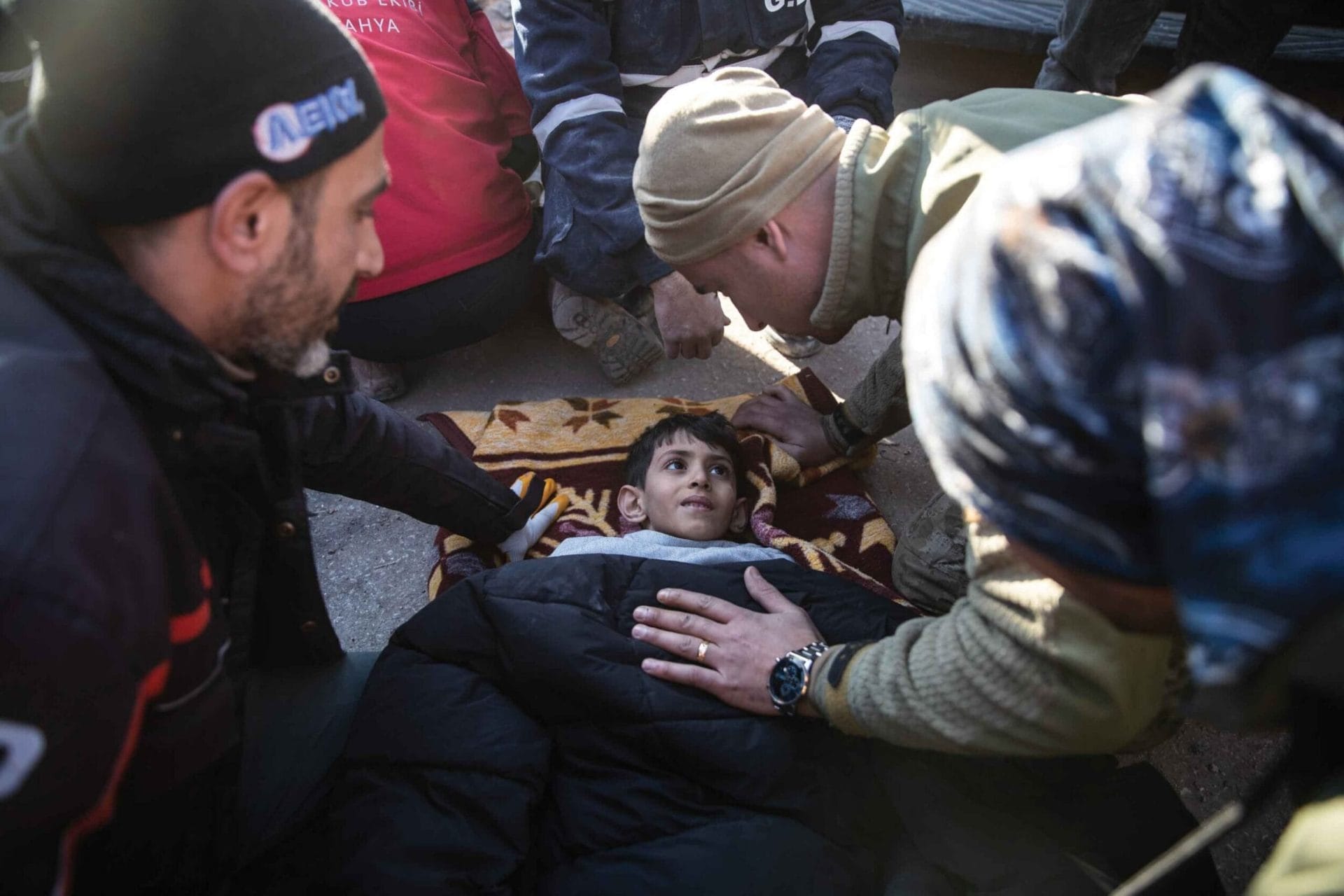
Rescue workers tend to Ahmet Findik, an 11-year-old survivor pulled from the rubble in Hatay 60 hours on from the earthquakes. Photo: Murat Sengul/Anadolu Agency via Getty Images
I watch the news for the first time in three days in the hotel lobby while anxiously checking out some minor cracks in the wall. President Erdoğan has begun a helicopter tour of the region to inspect the damage. He has visited a couple of cities to meet with earthquake victims, including Adiyaman, normally a stronghold for his Justice and Development Party, AKP. Over 60 percent of people here voted for him in the last elections so it was important for him to come. He has pledged to distribute 10,000 Turkish lira (£413) to “each of our families.” The pro-government channels A Haber and CNN Türk show rescue operations by professional AFAD-led teams, success stories of people found alive and pulled out of the rubble. Each time there are bursts of applause from bystanders, the tears of joy of family members and the exhausted but satisfied faces of rescue workers. To viewers it looks like the authorities have everything under control. There is no criticism of the government or the relief effort.
That night I’m woken up several times by aftershocks. Some real, some I dream. I’m relieved to get back into the car in the morning.
Thursday 9th February
It’s an hour and a half’s drive to Adiyaman, up in the mountains. I had been told that the destruction in the city had been underestimated and underreported. Three days after the earthquakes there is a constant sound of sirens on the outskirts of the city; ambulances, police and fire trucks. Dozens of excavators line the road. Every single building appears to be damaged and abandoned. Towards the centre, the picture gets worse. There are rows of concrete rubble piles, what used to be apartment blocks. As in Iskenderun people are on top of the rubble, digging with their hands.
I leave the car to continue on foot. In a side street I find a group of ten women on plastic garden chairs. They wear colourful headscarves, and are all crying. Around them there is nothing but rubble. One is singing a Kurdish mourning song. It is as if she is in a trance, singing and crying at the same time. It feels too intimate to approach them, but one of the women talks as soon as she sees me. “No one is coming, no one is asking [if we need help]. There is nobody. Our dead bodies are there, we cannot take them out. Is this how it is now? We are left alone,” she says. “He was shouting for help. There was no one to help him out. He is down there. Down there. He was crying out.” She is talking about her young nephew, who is only a child. She had heard his voice until last night. “‘Auntie, auntie,’ he was screaming. There is no one to take out the kids [still trapped in the rubble]. They are left alone.”
I ask whether she still hears voices from under the rubble. “No,” she says. From this morning, it has been painfully quiet. There is no more hope that their family members are still alive down there. She is angry now. “People come here to bring food. What are we going to do with food? Our bodies are down there. He was shouting. There was no one.”
If AFAD or other teams had come earlier, I’m sure many more people could have been rescued alive”
At the end of that day I speak to a young man who didn’t want to give his name. He is looking for the remains of his brother. “There is nothing left of Adiyaman,” he says. “My uncle’s daughter died. Two of her daughters died. His grandchildren. We took them out, they were unrecognisable. Who are we going to ask for help? We can find food, we can survive on dry bread if needed. But where is the state? Those people who are bringing aid from outside are saying, ‘Brother, we did not know about you. We didn’t know it was so bad in Adiyaman’. ” He is getting more angry as we talk. “There is no word from our mayor, no word from our governor, not any word from MPs. They are living on the salary we provided for them.”
He heard the speech Erdoğan gave, and he is furious about it. “It’s as if he is making fun of us. They are sending 10,000 lira into your accounts. What are we going to do with money? We lost lives. Everyone living in Adiyaman must hear this. If you have any honour, you will not vote for him again.”
Saturday 11th February
Five days after the earthquakes I return to Adiyaman, where I meet Ahmet Eren for the first time. He tells me that 14 of his family members have died, and that they are still looking for the body of one of them. He offers to take me to his family house, where the search continues. We drive through demolished streets. When we arrive, we meet his nephews and his uncle. They have been waiting there, hoping for a sign of the last family member yet to be recovered from the rubble: his uncle Halit’s elderly mother. An excavator from a construction company is digging through the rubble as Halit watches on. The family home had four floors, all now collapsed. “One of my nephews came out alive after 36 hours, but the rest were dead when we found them,” says Eren. It is here that I smell it for the first time. A penetrating, horrible smell that seems to stick to your skin. I realise it is the smell of people decomposing under the rubble.
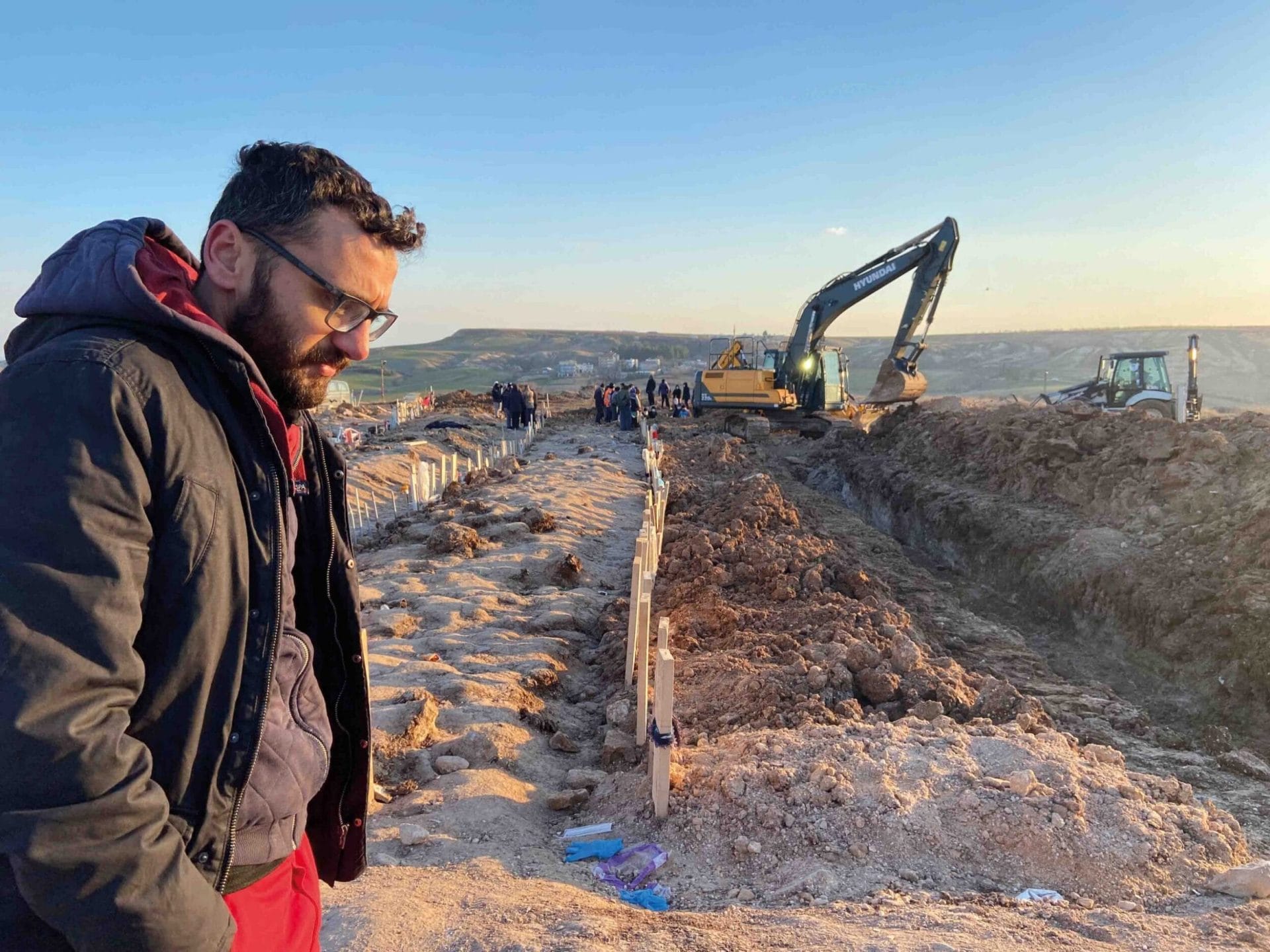
Ahmet Eren searches for the bodies of his family members among the mass graves at a cemetery in Adiyaman. Photo: Mitra Nazar
Eren has seen enough and that’s when he takes me to the graveyard at the edge of town to look for the final resting place of his aunt and two nieces, whose bodies he had pulled out of the family house himself when he arrived from the Netherlands. “I don’t know how long they had been dead. But if AFAD or other teams had come earlier, I’m sure many more people could have been rescued alive.” The bodies had quickly been spirited away from the rubble in the chaos. Eren knew he had almost no chance of finding where they had been buried at the graveyard, but he had to try.
It is here that I see the mass graves being dug, the bodies arriving wrapped in blankets. The grave mound covering a dead mother still holding her child. And then, suddenly, we see Ehren’s uncle Halit. He is no longer at the house, but standing next to a pick-up truck. A brightly coloured woollen blanket reveals there is a body in the truck, carried out by two men. Halit watches them work. Eren calls me over. “They found his mother,” he says. Her body is carried to the mass grave, and is delicately laid inside, next to the others. The imam prays. Halit and Ehren pray together and then walk away. They have to take care of the living now.
In the days after the earthquake one question persisted: why did so many buildings collapse? Thousands had crumbled like sand. The earthquakes were among the strongest in history, but could the number of deaths have been lower if the country had been better prepared? Most of the destruction was of old buildings but newer apartment blocks had fallen too. The construction of the luxurious Rönesans Rezidans in Antakya started in 2012, and was completed in 2013. Advertised as an earthquake-proof “piece of paradise” built to the “highest construction standards”, it had 12 floors, 250 apartments, a swimming pool and a gym. Over 700 people were living there at the time the earthquake hit. Within minutes, the massive block had collapsed. It is still unclear how many died there, perhaps hundreds. Former Newcastle United and Chelsea football player Christian Atsu was one of them. He had scored a last-minute winning goal for Hatayspor, who play in Turkey’s top league, the night before the earthquake. His body was recovered nearly two weeks later.
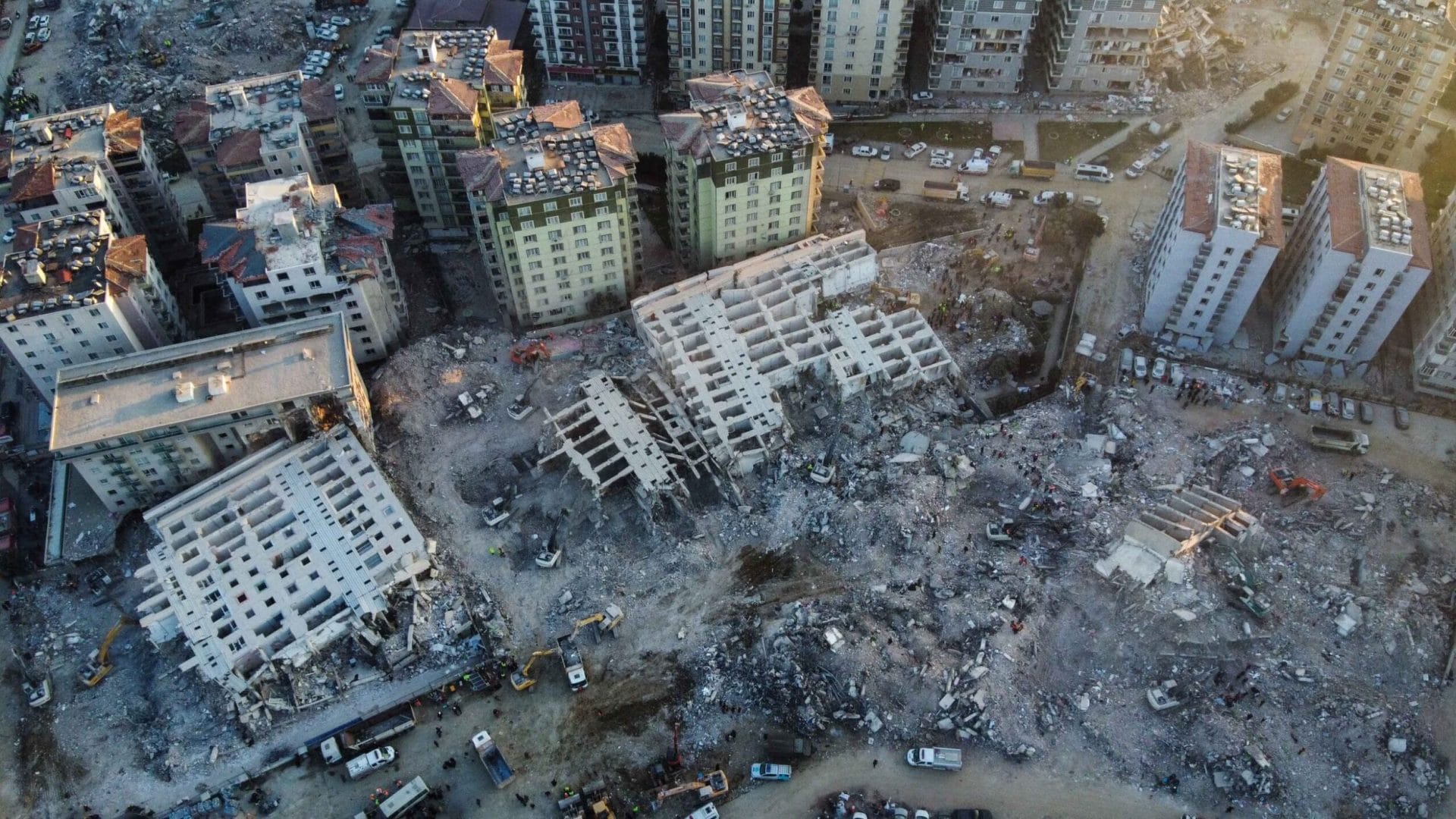
An aerial view of Rönesans Residence, which collapsed during the earthquakes. Over 700 people were living at the apartment block at the time. Photo: Mehmet Malkoç/SOPA Images/LightRocket via Getty Images
The collapse of Rönesans has become symbolic of Turkey’s current political system. Stricter earthquake safety regulations had been introduced after a 7.4 magnitude quake hit the area around the city of Izmit in Kocaeli province in 1999, killing at least 17,000 people. But construction firms lobbied against the new rules. According to the Union of Chambers of Turkish Engineers and Architects (TMMOB), up to 75,000 buildings in the area affected by February’s earthquakes were covered by controversial building ‘amnesties’. Although these have been brought in at various times over the years, a 2018 amnesty law introduced by Erdoğan’s government was by far the biggest. It enabled buildings to remain open, even if the developers had not complied with the post-1999 earthquake building codes, and covered more than three million buildings across the country. Construction firms simply had to pay a fine. Cities were growing, and people needed to live somewhere. By legalising tens of thousands of buildings, Erdoğan could claim he had solved the housing problem. In 2019 TMMOB called the amnesty law “attempted murder”, but many more amnesties were granted after that. Erdoğan even planned to give out a few more this year. Those have now been cancelled.
Erdoğan’s early popularity was fuelled by rapid economic growth and development of the country. Under his watch Turkey underwent a boom with massive infrastructure and building projects. The building sector was considered the engine of the growing economy, giving it outsized power and political influence. Cities were expanding fast, especially in the southeast. Kahramanmaras and Gaziantep were dubbed ‘Anatolian Tigers’ because of their rapid economic growth. Plenty of land was made free for building. Little or no attention was given to the ground or the building processes themselves, says lawyer Eser Duran from the Hatay Bar Association. He cites Hatay airport, which was seriously damaged by the February earthquakes, with the asphalt from its only landing strip torn apart. It was unusable for days, making it more difficult to deliver aid in the immediate aftermath of the disaster. The airport was built on a drained lake, Duran tells me. Serious concerns had been raised in 2010, before it was built. The Union of Chambers of Engineers and Architects had warned about the soft ground and the risks in case of a strong earthquake, but were ignored.
Within a few days of the February quakes, the Turkish authorities started to arrest contractors behind collapsed buildings, including the firm behind the Rönesans building in Antakya. But critics soon pointed fingers towards the government itself. “There is a chain of accountability,” says Duran, who is in a group of independent lawyers investigating damaged buildings and rubble. “After the contractors you have the inspectors, who are responsible for approving building plans. Then there are the local authorities. And lastly, the state itself. They let this happen [on] their watch.” Duran has been taking photos and collecting samples of concrete and steel from collapsed buildings for what he hopes will be “mass court cases”, before the evidence is removed. “They [the authorities] are already cleaning up the rubble here,” he says. “We have to do this now, before it’s too late.”
Over the years experts like Duran have warned that the country was not ready for another earthquake. The disaster of 1999 brought the discussion about safety – in one of the most active earthquake zones on earth – to the foreground and helped usher in the Erdoğan era. Immediately after the 1999 earthquake, in an echo of today’s situation, there was anger at the slow response of the government as well as the poor state of the buildings that had collapsed causing so many deaths.
The Izmit earthquake increased awareness of Turkey’s vulnerabilities and the authorities got serious about building regulations. But the leftist secular government of that time did not survive the disaster and were voted out in the next elections in 2002. A new party came to power: the Justice and Development Party (AKP), run by a talented and energetic conservative politician. Erdoğan made huge political capital out of the previous government’s earthquake failures and promised to do everything differently. He vowed that he would do away with corruption in the building sector. An earthquake tax had been brought in after the 1999 disaster to help fund redevelopment and to prepare the country for the next inevitable “big one”. It would be put to good use, he said.
Yet 20 years later the same geological forces that helped make Erdoğan’s political career also had the potential to end it. For one, the money from the earthquake tax, still being levied today, was either not there or was misused when the February earthquakes hit. The opposition Republican People’s Party, the CHP, claimed that the money had been fraudulently used by those in power. “Where is that money? That money is gone. People who have been paying taxes to the state all their lives are unable to see that state once they need it,” said CHP leader Kemal Kilicdaroglu.
Erdoğan was aware of the political damage caused by the earthquakes. In late February he publicly apologised for the slow response during a speech in Adiyaman. “Due to the devastating effects of the quakes and the bad weather and damaged infrastructure, we were not able to work the way we wanted in the first few days,” he said in front of a crowd of people. “Like any human, we can have defects and can make mistakes. For this, I apologise.”
Political scientist Seren Selvin Korkmaz found the apology remarkable. “I think it’s the first time in his career that he apologised for something that he was responsible for,” she says. But she also saw it as necessary damage control in order to maintain support ahead of upcoming elections, perhaps Turkey’s most consequential since the state was founded by Mustafa Kemal Ataturk 100 years ago, in 1923.
The presidential election on 14th May 2023 had already been shaping up to be the biggest threat to Erdoğan’s 20 year rule. Turkey’s economy was already in tatters before the earthquakes, with inflation topping 100 percent driven by Erdoğan’s highly unorthodox economic policies. The president, however, with much of the state and a neutered media now behind him, was still confident of winning. Until the earthquake, that is. “When we look at many of the earthquake areas, people mainly support the AKP there,” says Korkmaz. Erdoğan told the people in Adiyaman that he would deal with the damage in the cities impacted by the earthquakes. Everyone would be sure to have a house to live in within a year, he promised. “Do not listen to the fools who attacked the government services responsible for dealing with the crisis,” he added.
In early April, two months after the earthquakes, I return to Adiyaman. More than 50,000 have died in Turkey, just over 7,000 in Syria. The UN estimates that 1.5 million people have been made homeless in the two countries. On the outskirts of the city, in an agricultural field, trucks and excavators are driving back and forth. This time, it’s not to clear the rubble or to search for survivors under collapsed buildings – they are building new homes. The concrete foundations have been laid, steel pipes have been put in place. The project to provide flats for 7,000 people is being run by TOKI, the state housing development administration. The opening of the building site was broadcast on national television. Erdoğan was there to watch as the first cement was poured into the ground.
However, experts have warned that building so soon after the earthquake is a bad idea. There are still aftershocks, and a thorough investigation is needed into how suitable the ground is for putting up apartment blocks. A group of scientists has written an open letter to the government urging them “not to make the same mistakes again… Hasty decisions should not be made.” But an election needs to be won. Erdoğan has already announced he will build a quarter of a million new homes for victims within the year. Similar construction sites have since opened in Kahramanmaras, Gaziantep and Malatya.
The clean-up in the city centre continues. There are people roaming around the rubble, searching for things they can sell. Nobody is living in buildings here, I’m told. It’s estimated that half of the population has left. The other half is living in tents or shipping containers, in camps or between the rubble. “He wants to build us houses in a year?” exclaims Halil, a taxi driver sitting in the street near his cab. “They did a similar housing project in my district in 2017 and they didn’t finish it in five years. Believe me, they can’t even finish cleaning the rubble in one year.”
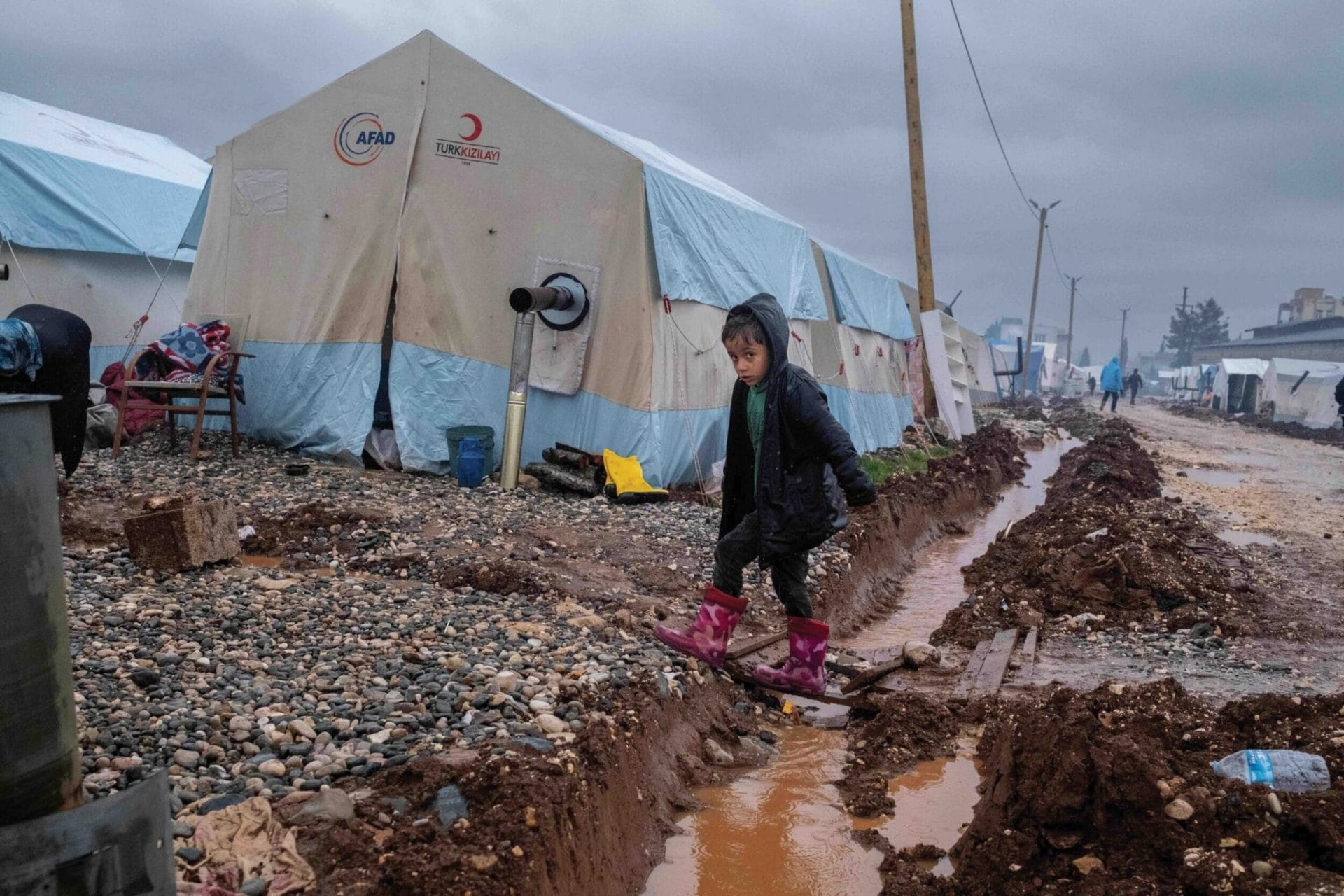
A child crosses a ditch to reach tents set up to house people displaced by the earthquakes in Adiyaman, 25th March 2023. Photo: Bulent Kilic/AFP via Getty Images
Halil has started working again. The taxi office he and his colleagues worked from had collapsed during the earthquake and has been replaced with a shipping container. On the other side of the street the AKP is renovating a building with minor damage into a regional election headquarters. A huge photo of Erdoğan covers the building’s facade. Halil points towards it when he tells me he used to support the AKP. “We voted for him for 20 years. I was a volunteer for the party. But they have done nothing for this country. And they left us alone after the earthquake.” He says he is no longer afraid to say it out loud. “I think the whole system needs to change from top to toe. I think we deserve a change.”
Korkmaz says it is hard to predict if Erdoğan will be punished at the ballot box for the handling of the earthquake. He will be up against Kemal Kilicdaroglu, leader of the secular, centrist CHP, who has managed to unite the previously divided opposition movement behind him. Polls show that Erdoğan is in trouble, but it is too early to write his political obituary. “Whenever there is a crisis, people tend to ask for stability,” says Korkmaz. “As soon as the earthquake happened, Erdoğan began to talk about rebuilding the cities. He made promises. He will invest all of his electoral campaign into reconstruction, and telling people that he is the only one who can do it.”
Erdoğan is now blaming the opposition for not being sensitive towards the earthquake victims. He has banned all music from campaigning, out of respect. He has also placed helping the earthquake victims at the centre of his campaign. His message to the people, carried by the overwhelmingly pro-government media, is that the opposition is selfish, and they won’t be able to rebuild the affected areas. Many tent camps in Adiyaman are now managed by the AKP governor, appointed by Ankara. Unlike the first days after the quakes, the state is now very visible here. Food, clothes and toys for the kids are all handed out to the people who live in tents. Before I leave I visit one last camp. “Of course, there were some difficulties. In the first phase we had some trouble,” says Mehmet, who lives in a big tent with his extended family. “But right now, our state is behind us, providing us everything, food and all… We have great support from them.” He always voted for Erdoğan, he tells me. And he will do so again.
Postscript
Mehmet did vote for Erdoğan again. As did many others. On 14th May 2023, the world watched the first round of Turkey’s presidential election as Erdoğan consolidated his power over the country. Despite everything – the earthquakes, the hyperinflation, the ever-growing repression of freedoms – enough Turks stayed loyal to him. I was in Istanbul on election night, watching the results come in. The opposition were confident they would win. Polls suggested they might even pass the 50 percent mark, eliminating the need for a second round run-off. But it was not to be. Erdoğan won just over 49 percent of the vote, the opposition candidate Kilicdaroglu just below 45 percent. Erdoğan did lose votes compared to the previous presidential election in 2018, but nearly half the population put their trust in him once again.
Erdoğan’s campaign strategy had worked. Enough people believed that he could rebuild the country after the earthquakes and that he was going to be the right person to fix the economy, regardless of the fact that it was economic mismanagement under his rule that had brought many Turks to the edge of poverty to begin with. He also boosted military investments during the campaign and discredited the opposition, calling them friends of terrorists. This was based on the fact that many Kurds, a discriminated-against minority who make up as much as 15 percent of the vote, said they would vote for Kilicdaroglu. As in many elections before, this one took place on an uneven playing field. Over the years, Erdoğan has seized control of around 90 percent of the media in Turkey. And the most popular opposition figure, Istanbul mayor Ekram Immamoğlu, was prevented from standing after a spurious legal case was launched against him for “insulting” election officials in 2019.
At the second round on 28th May 2023, Erdoğan cemented his position, winning 52.2 percent of the vote. It looks like Turkey’s two-decade strongman is not going anywhere just yet. Perhaps most surprisingly he retained his support in almost all of the earthquake-hit provinces. It turned out that Mehmet was not alone. In Adiyaman, 68.8 percent of the voters chose Erdoğan. Compared to the 2018 election, his vote there actually went up.
Slow Journalism in your inbox, plus infographics, offers and more: sign up for the free DG newsletter. Sign me up
Thanks for signing up.
